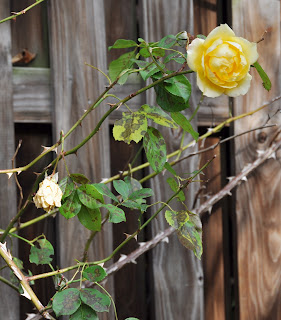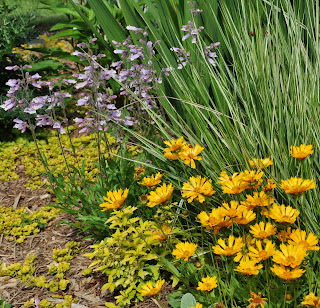Its raining again, which means the many things that need to be done outside are not having any progress made. I was able to run the mower over part of the grass, which vacuums up the leaves and chops them up while trimming the now brown zoysia grass low for spring. Above you can see the Maryland Senna seed heads that need to be trimmed off, but for now they provide a nice profile in front of the Chesapeake.
There is one leaf left on the Serviceberry, Amelanchier canadensis, glowing in the otherwise gray light. It is the one bit of color left outside. The tree is the remaining one of about a dozen saplings I bought from a mail order nursery many years ago. Most died within the first year, since I was trying to establish them in the sandy hill behind the house and it was a dry summer. When I found two had survived, I took pity on them,and moved both up to the edge of the vegetable patch. Once they had gained some size, I expected to return them. This one survived the move, and has claimed its place outside the kitchen window, beside the shed. As long as it doesn't get too big and block the view out the window, I will allow it a place.
Perhaps more fitting for the somberness of the day, is the Cunninghamia Konishii tree that grows on the edge of the ravine. Known as the Taiwan Fir, even though it is not really a fir, this originally was bought at a National Arboretum sale in 1998. I loved the foliage, but never really had a place for it on the small city lot we owned, so it stayed in a pot for two years. It was one of the first trees planted on the side of the ravine in 2001, and has grown to over 25 feet tall. In this perspective the size of the trunk is dramatic, with the green of the dwarf bamboo, Shibataea Kumasaca that are about 4 feet high. About five years ago I moved about a dozen bamboo roots into the area below the Cunninghamia because it was rapidly eroding, soil sliding down 60 feet to the bottom. The bamboo seems to be holding the soil well, at least protecting the top layer. I hope so. I want to keep the tree for a long time.
Finally, a shot from November, with Broddy surveying her domain. When I tried a few minutes ago to get her to chase a squirrel from the bird feeder with me, she stopped inside the door and gave me a look of disdain. Why would she want to go out when it is cold and wet? Maybe she is the sane one, since my feet are now damp and cold, and the squirrel has probably back, having driven the birds away and chowing down on sunflower seeds. I better go check.























































